Introduction
East Asia's increasing reliance on exports for growth
Effects of increasing exports on the economies of East Asia
Conclusion
The growing dependence of East Asian1 economies on exports
East Asian economies have become more integrated with the world economy through increased trade and expanded exports of electronic goods.2 Many of these economies are being severely affected by the current global downturn.
Introduction
This article briefly documents the growing dependence of East Asian economies on trade - particularly on exports to the US market for electronic goods - with a view to better understanding the current downturn in these economies.3
East Asia's increasing reliance on exports for growth
Table 1 shows that East Asia's trade linkages with the rest of the world have increased substantially, reflecting both the growing export-orientation of these economies and the general trend of trade liberalisation in the world. Most countries in the region now have trade levels (when measured as a per cent of GDP) well above global averages.
Table 1: Exports and imports of goods and services as a per cent of GDP
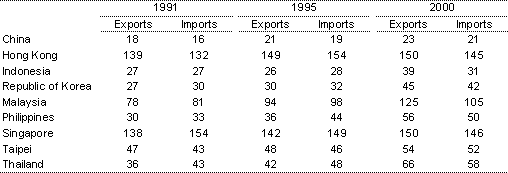
Source: CEIC database. Export data for Hong Kong and Singapore include both domestic exports and re-exports. Re-exports are goods that have been imported and are then exported without having undergone any material change while in the exporting country.
In particular, East Asia's exports have increasingly been in high technology industries (see Table 2, which shows the value of exports of electronic goods of East Asian economies as a per cent of total exports, and measured against GDP). As such, East Asia's exports have increasingly depended on the markets of the US and Japan (see Table 3, which shows the value of total exports from East Asian economies that went to the US and Japanese markets, as a share of GDP).
Table 2: Electronic exports as a per cent of total exports and GDP
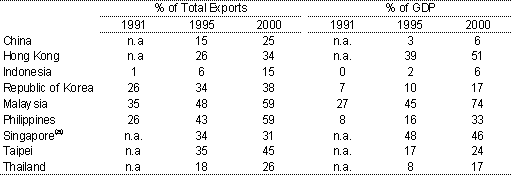
(a) Domestic electronic exports only and 1995 figures are 1996 data.
Source: CEIC database.
Table 3: Exports to Japan and US as a per cent of GDP
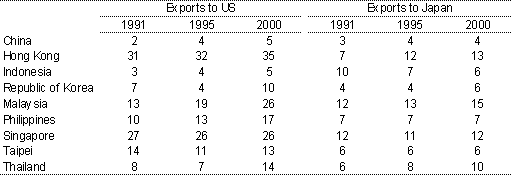
Source: CEIC database.
Effects of increasing exports on the economies of East Asia
The strong export-orientation in East Asian economies over the past decade has contributed significantly to their rapid recovery from the downturn associated with the 1997-98 crisis. There was relatively little recovery in domestic demand, notwithstanding accommodative fiscal and monetary conditions. As noted above, East Asia's exports have increasingly been IT-related. Morgan Stanley estimates that as much as two-fifths of Asia's total GDP growth last year came from exports of IT to America (`Falling (again)', The Economist, 7 July 2001, p 11).
By the same token, this strong export-orientation has increased their vulnerability to the current slowdown in the US and Japan.
Table 4 shows that the value of exports of electronic goods from East Asian economies has turned down sharply since late last year. This is also reflected in the downturn of exports to the US market (Table 5). The use of through-the-year figures may not fully capture the extent of the drop in exports. However, seasonally adjusted quarterly data are not available.
Table 4: Electronic exports, nominal
(per cent change, through the year)(a)
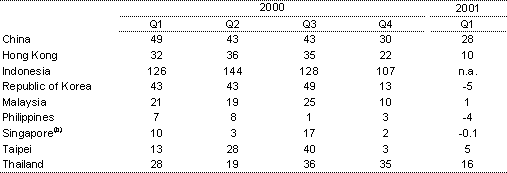
(a) Constant price data are not available and data on a seasonally adjusted basis are not available quarterly.
(b) Domestic electronics exports only.
Source: CEIC database.
Table 5: Exports to the US, nominal
(per cent change, through the year)(a)
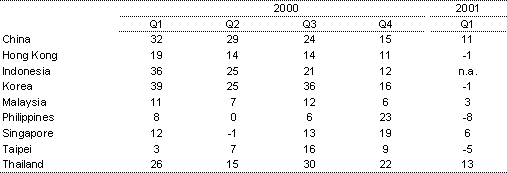
(a) Constant price data are not available and data on a seasonally adjusted basis are not available quarterly.
Source: CEIC database.
The linkage of electronic exports of East Asia to US demand is illustrated in Chart 1 which compares the US semi-conductor book-to-bill ratio (namely, the ratio of new orders to shipments) with real East Asian export growth. Chart 1 shows that East Asian exports recovered strongly following the Asian crisis as a result of buoyant US demand for electronic goods, but that they slowed sharply from late 2000, as the demand for electronic goods faltered in the US.
Chart 1: East Asia (ex China) real export growth
(per cent, through the year) and
US semiconductor book to bill ratio
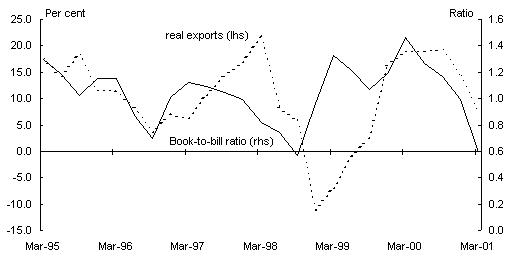
Source: CEIC database, IMF PPP weights (2001) and website economy.com.
While trade between East Asian economies has increased over the past decade (see Table 6), it appears the bulk of intra-regional exports have comprised shipments of components among linked production sites. This trade ultimately reflects a derived demand for final products from more developed countries, particularly the US. The downturn in the US seems to have reduced East Asia's direct exports to that market and is likely to have reduced its intra-regional trade.
Table 6: Intra-regional trade of the five crisis-affected economies(a)

(a) Indonesia, Republic of Korea, Malaysia, the Philippines, and Thailand.
(b) China, Hong Kong, Indonesia, Republic of Korea, the Philippines, Singapore, Taipei, Thailand, and Vietnam.
Source: Asian Development Bank, Asia Recovery Report October 2000.
Growth in the volume of world trade has slowed to around 4 per cent this year from 13 per cent last year, the sharpest downturn since 1975 (`Falling (again)', Economist, 7 July 2001, p 11). Table 7 shows that total exports from East Asian economies, measured in real terms, have slowed significantly. As exports have slowed, industrial production has begun to slow, investment has begun to slacken, and consumption has also weakened (see Charts 2, 3 and 4), although, as noted above, fiscal and monetary conditions in East Asia have been accommodative. Real GDP has begun to slow markedly (see Chart 5 and Table 8). Singapore is now in a recession, while Thailand, Taipei and the Philippines suffered quarter-on-quarter negative growth in the first quarter of 2001. By contrast, China seems the only economy in East Asia that continues to grow strongly, on the back of very strong growth in domestic investment, especially public works. China has also increased its market share
in the US and EU markets (Asian Economic and Strategy Perspectives, UBS Warburg, June 2001).
Table 7: Real Export Growth (per cent, through the year)(a)
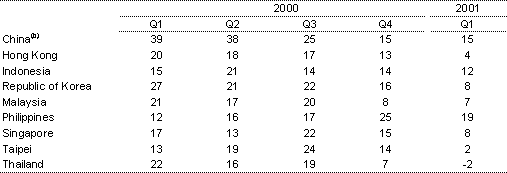
(a) Seasonally adjusted quarterly data are not available for most East Asian countries.
(b) In nominal terms.
Source: CEIC database.
Table 8: Real GDP Growth (per cent)
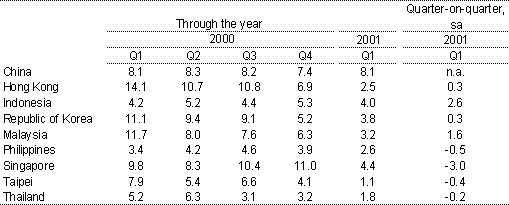
Source: CEIC database. Quarter-on-quarter figures for Indonesia, Taipei and Malaysia are seasonally adjusted by Treasury.
Chart 2: East Asia (ex China) real export growth and industrial production (per cent, through the year)
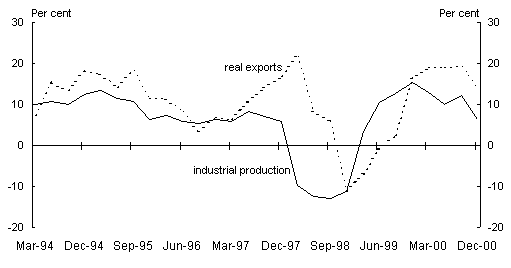
Source: CEIC database and IMF PPP weights (2001).
Chart 3: East Asia (ex China) real export growth
and investment growth (per cent, through the year)
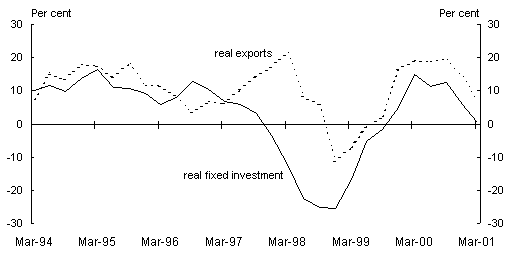
Source: CEIC database and IMF PPP weights (2001).
Chart 4: East Asia (ex China) real export growth
and private consumption growth (per cent, through the year)
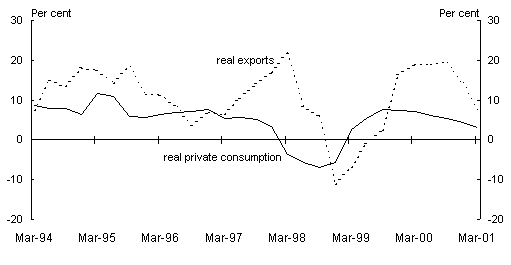
Source: CEIC database and IMF PPP weights (2001).
Chart 5: East Asia (ex China) real export growth
and GDP growth (per cent, through the year)
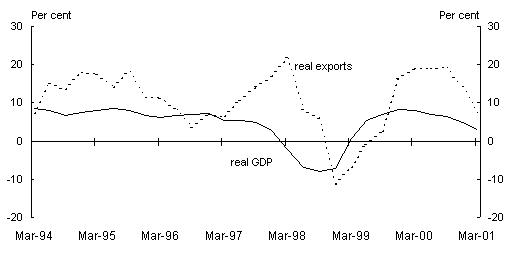
Source: CEIC database and IMF PPP weights (2001).
Conclusion
East Asia's increasing reliance on exports, and particularly high technology exports, helped most of the region to recover from the 1997-98 crisis. It now exposes the region to greater risk, as world demand for such exports, and for exports more generally, is slowing sharply.
Growth in the US is expected to recover later this year. However, given the apparent heavy over-investment of US firms in information and communication technology in recent years, this recovery may not be accompanied by a revival in spending on such products, thereby resulting in a slower recovery in demand for East Asian electronic exports.
1 In this paper, East Asia includes the economies of China, Hong Kong, Indonesia, Republic of Korea, Malaysia, the Philippines, Singapore, Taipei and Thailand, but excludes Japan. Hong Kong refers to Hong Kong (China) and Taipei to Taipei (China).
2 In this article, `electronics' refers to office machines and parts, automated data processing machines, telecommunications and sound recording and reproducing equipment, electrical machinery and apparatus and appliances.
3 Data limitations mean that some `proxy' measures must be used to highlight aspects of discussion.